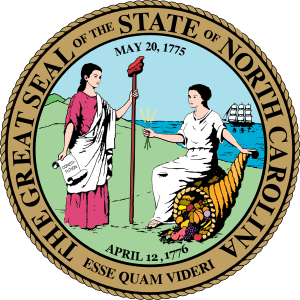Rowan County, North Carolina
Rowan County is a county located in the U.S. state of North Carolina and formed in 1753 as part of the British Province of North Carolina. While originally a vast territory with unlimited western boundaries, its size was reduced to 524 square miles after several counties were formed from Rowan County in the 18th and 19th century. As of the 2010 census, the population was 138,428.[1] Its county seat, Salisbury, is the oldest continuously populated town in western North Carolina.[2] Rowan County is located northeast of Charlotte and it is considered part of the metropolitan area.
Rowan County | |
|---|---|
 Rowan County courthouse | |
 Seal | |
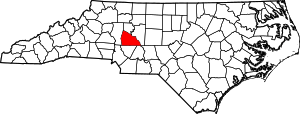 Location within the U.S. state of North Carolina | |
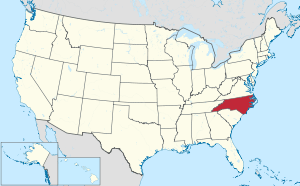 North Carolina's location within the U.S. | |
| Coordinates: 35°38′N 80°31′W | |
| Country | |
| State | |
| Founded | 1753 |
| Named for | Matthew Rowan |
| Seat | Salisbury |
| Largest city | Salisbury |
| Area | |
| • Total | 524 sq mi (1,360 km2) |
| • Land | 511 sq mi (1,320 km2) |
| • Water | 12 sq mi (30 km2) 2.4%% |
| Population | |
| • Estimate (2019) | 142,088 |
| • Density | 271/sq mi (105/km2) |
| Time zone | UTC−5 (Eastern) |
| • Summer (DST) | UTC−4 (EDT) |
| Congressional districts | 8th, 13th |
| Website | www |
History
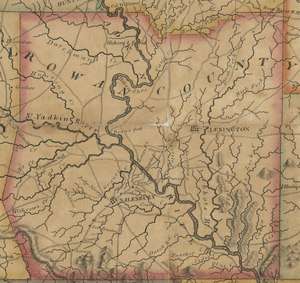
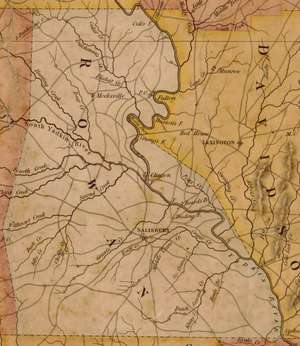
The first Europeans to enter what is now Rowan County were the members of the Spanish expedition of Juan Pardo in 1567. They established a fort and a mission in the native village of Guatari, believed to be located near the Yadkin River and inhabited by the Wateree. At the time, the area was ruled by a female chief whom the Spaniards called Guatari Mico (Mico was the Wateree's term for chief). The Spaniards called the village Salamanca in honor of the city of Salamanca in western Spain, and established a mission, headed by a secular priest named Sebastián Montero. Pardo returned to Spain in 1568,[3] and the Native Americans massacred all but one soldier at the six forts Pardo had established in the interior. The Spanish never returned to the area.[4][5]
English colonial settlement of North Carolina came decades later, starting with the coastal areas, the settlers moving south from Virginia. Explorers and fur traders were the first to reach the Piedmont, paving the way for eventual settlers. Rowan County was formed in 1753 from the northern part of Anson County. It was named for Matthew Rowan, acting governor of North Carolina from 1753 to 1754. It was intended to incorporate all of the lands of the Granville District that had been included in Anson County.[6]
As was typical of the time, Rowan County was originally a vast territory with an indefinite western boundary. Reductions in the county's size began in 1770, when the eastern porton was combined with the western part of Orange County to form Guilford County. In 1771 the northeastern portion of what was left became Surry County. In 1777 the western part of Rowan County became Burke County.[7]
After the American Revolutionary War, in 1788 the western portion of the now much smaller Rowan County was organized as Iredell County, and in 1822 the eastern part became Davidson County. Finally, in 1836 that part of Rowan County north of the South Yadkin River became Davie County and Rowan County was reduced to its present size.[7]
The county has worked to attract new industries since much of the textile industry moved offshore in the late 20th and early 21st centuries. The "250 Fest", celebrating the 250th anniversary of Rowan County, was held in 2003.[8]
Racial tension
Rowan County was developed for cotton cultivation and mixed farming in the antebellum period. Cotton continued as a commodity crop for some time. Following Reconstruction, there was continuing change in the county, with industrialization following the construction of railways and textile mills here and elsewhere in the Piedmont. Urban populations increased. A total of six lynchings of African Americans were recorded here in this period, which extended into the early 20th century. This was the second-highest total in the state, a number of extrajudicial murders that two other counties also had.[9]
At the turn of the 20th century, the state had passed a new constitution in 1868 and later laws erecting barriers to voter registration that effectively disenfranchised most blacks, ending their political progress for decades, after African Americans had been elected to Congress from this state and there had been a Republican-Populist fusionist slate. Both governors Charles Aycock and Robert Glenn, elected in 1900 and 1904, respectively, ran campaigns to appeal to whites. It was not until after passage of civil rights legislation that most African American recovered the ability to vote; they had never lost their constitutional right as citizens.[10]
The racial terrorism of lynchings enforced white suppression of African Americans. In 1902 brothers James and Harrison Gillespie, aged 11 (eleven) and 13 (thirteen), were lynched by a white mob for allegedly killing a young white woman working in a field.[10] In August 1906, six African-American men were arrested as suspects in the murder of a farm family. That evening, a white mob stormed the county jail in Salisbury, freeing all the white prisoners, interrogating the black ones, and taking out Jack Dillingham, Nease Gillespie, and his son John. The mob hanged the three men from a tree in a field, mutilated and tortured them, and shot them numerous times.[10]
Geography
According to the U.S. Census Bureau, the county has a total area of 524 square miles (1,360 km2), of which 511 square miles (1,320 km2) is land and 12 square miles (31 km2) (2.4%) is water.[11]
The county's eastern border is formed by the Yadkin River. North of Ellis Crossroads, the South Yadkin River meets the Yadkin. The South Yadkin forms the county's northern border, with Davie County.
The southern border is an east-west line that bisects the city of Kannapolis.
Adjacent counties
- Cabarrus County - south
- Davidson County - east
- Davie County - north
- Iredell County - west
- Stanly County - southeast
Major highways
Interstate 85 passes through the county from southwest to northeast. In the early 2000s, I-85 underwent an extensive widening[12] in the central and northern part of the county, from exit 68, US 29 Connector north almost to the Davidson county line. A new bridge over the Yadkin River is planned.[13]
U.S. Route 70 enters the northwestern part of Rowan county, west of Cleveland. It runs southeast into Salisbury, where it follows Jake Alexander Boulevard to the southeast and then joins US 29 North as Main Street. US 70 continues northeast as Main Street and then Salisbury Avenue in Spencer before crossing into Davidson County.
U.S. Route 29 forms Main Street in Kannapolis, China Grove, and Landis in the southern part of the county. It joins US 70 as Main Street through Salisbury, and as Salisbury Avenue in Spencer.
U.S. Route 52 is the main artery for the southeastern part of the county, serving the towns of Gold Hill, Rockwell and Granite Quarry. Just before reaching downtown Salisbury, US-52 joins Interstate 85, which it follows into Davidson county.
Demographics
| Historical population | |||
|---|---|---|---|
| Census | Pop. | %± | |
| 1790 | 15,972 | — | |
| 1800 | 20,060 | 25.6% | |
| 1810 | 21,543 | 7.4% | |
| 1820 | 26,009 | 20.7% | |
| 1830 | 20,786 | −20.1% | |
| 1840 | 12,109 | −41.7% | |
| 1850 | 13,870 | 14.5% | |
| 1860 | 14,589 | 5.2% | |
| 1870 | 16,810 | 15.2% | |
| 1880 | 19,965 | 18.8% | |
| 1890 | 24,123 | 20.8% | |
| 1900 | 31,066 | 28.8% | |
| 1910 | 37,521 | 20.8% | |
| 1920 | 44,062 | 17.4% | |
| 1930 | 56,665 | 28.6% | |
| 1940 | 69,206 | 22.1% | |
| 1950 | 75,410 | 9.0% | |
| 1960 | 82,817 | 9.8% | |
| 1970 | 90,035 | 8.7% | |
| 1980 | 99,186 | 10.2% | |
| 1990 | 110,605 | 11.5% | |
| 2000 | 130,340 | 17.8% | |
| 2010 | 138,446 | 6.2% | |
| Est. 2019 | 142,088 | [14] | 2.6% |
| U.S. Decennial Census[15] 1790-1960[16] 1900-1990[17] 1990-2000[18] 2010-2019[1] | |||
As of the census[19] of 2010, there were 138,428 people, 53,140 households, and 37,058 families residing in the county. The population density was 270.7 people per square mile (98/km²). There were 60,211 housing units at an average density of 117.7 per square mile (41/km²). The racial makeup of the county was 76.52% White, 16.18% Black or African American, 0.34% Native American, 1.00% Asian, 0.035% Pacific Islander, 4.33% from other races, and 1.60% from two or more races. 7.69% of the population were Hispanic or Latino of any race.
Of the 53,140 households, 29.30% had children under the age of 18 living with them, 50.20% were married couples living together, 8.49% had a female householder with no husband present, 5.41% had a male householder with no wife and 30.26% were non-families. 25.22% of all households were made up of individuals and 10.15% had someone living alone who was 65 years of age or older. The average household size was 2.52 and the average family size was 3.00.
In the county, the population was spread out with 23.80% under the age of 18, 9.00% from 18 to 24, 25.40% from 25 to 44, 27.40% from 45 to 64, and 14.40% who were 65 years of age or older. The median age was 39.1 years. For every 100 females there were 97.57 males. For every 100 females age 18 and over, there were 95.28 males.
According to the 2000 Census,[20] The median income for a household in the county was $37,494, and the median income for a family was $44,242. Males had a median income of $31,626 versus $23,437 for females. The per capita income for the county was $18,071. About 8.10% of families and 10.60% of the population were below the poverty line, including 13.70% of those under age 18 and 11.40% of those age 65 or over.
Law and government
The primary governing body of Rowan County follows a council–manager government format with a five-member Board of Commissioners and the County Manager. The current County Manager is Aaron Church. The current Commissioners are: Greg Edds (Chairman), Jim Greene (Vice-Chairman), Judy Klusman, Mike Caskey and Craig Pierce. Commissioners are elected to four year terms with three being elected during midterm elections and two being elected during presidential elections.[21] The commission passes the Code of Ordinances for the county.[22]
Rowan County is a member of the regional Centralina Council of Governments.[23]
In the State Legislature, Rowan is represented in the Senate by Andrew C. Brock in the 34th district and Tom McInnis in the 25th. In the House, Rowan is represented by Carl Ford in the 76th district and Harry Warren in the 77th district. Both Senators and House Representatives are elected to two year terms.[24]
In the US Senate, the county is represented by Richard Burr and Thom Tillis.[25] Rowan is split between two US House districts, the 8th congressional district and North Carolina's 13th congressional district[26]
The current Sheriff of Rowan County is Kevin L. Auten who took over the position after the retirement of George Wilhelm in 2009. Auten won election to a full term in 2010. For a complete list of sheriffs, see Rowan County Sheriff's Office[27]
County commission prayer
In 2013 the American Civil Liberties Union filed suit on behalf of three Rowan county residents against the county commission's practice of starting their meeting with sectarian prayers by the commissioners instructing attendees to stand and join in. A federal district court issued an injunction forbidding the county commissioners from praying at their meetings.[28][29] After a divided panel of the United States Court of Appeals for the Fourth Circuit found that the prayers did not violate the Establishment Clause of the United States Constitution, the full court sitting en banc disagreed and affirmed the injunction.[30][31] The Supreme Court of the United States then denied review, over the written dissent of two justices.[32][33] In 2019, the county was forced to pay $285,000 to the ACLU for the plaintiffs' legal fees.[34]
Politics
| Year | Republican | Democratic | Third parties |
|---|---|---|---|
| 2016 | 66.5% 42,810 | 30.1% 19,400 | 3.4% 2,159 |
| 2012 | 62.2% 38,775 | 36.4% 22,650 | 1.4% 887 |
| 2008 | 60.8% 37,451 | 38.0% 23,391 | 1.2% 718 |
| 2004 | 67.3% 34,915 | 32.3% 16,735 | 0.4% 217 |
| 2000 | 65.5% 28,922 | 33.7% 14,891 | 0.7% 320 |
| 1996 | 57.9% 22,754 | 34.3% 13,461 | 7.8% 3,058 |
| 1992 | 49.8% 21,297 | 33.5% 14,308 | 16.7% 7,127 |
| 1988 | 65.5% 23,192 | 34.2% 12,127 | 0.3% 97 |
| 1984 | 70.2% 25,207 | 29.6% 10,643 | 0.2% 57 |
| 1980 | 59.7% 18,566 | 37.5% 11,671 | 2.8% 872 |
| 1976 | 48.4% 14,644 | 50.8% 15,363 | 0.7% 222 |
| 1972 | 73.3% 20,735 | 24.2% 6,834 | 2.5% 705 |
| 1968 | 46.8% 15,207 | 24.8% 8,074 | 28.4% 9,220 |
| 1964 | 49.8% 14,804 | 50.2% 14,934 | |
| 1960 | 57.8% 17,726 | 42.2% 12,919 | |
| 1956 | 64.3% 17,562 | 35.7% 9,761 | |
| 1952 | 60.8% 17,535 | 39.2% 11,296 | |
| 1948 | 36.4% 5,722 | 43.3% 6,799 | 20.3% 3,181 |
| 1944 | 37.6% 5,862 | 62.4% 9,721 | |
| 1940 | 23.8% 4,059 | 76.2% 13,023 | |
| 1936 | 25.2% 4,306 | 74.8% 12,808 | |
| 1932 | 30.9% 4,464 | 67.8% 9,782 | 1.3% 180 |
| 1928 | 62.5% 7,957 | 37.5% 4,783 | |
| 1924 | 39.1% 3,560 | 52.8% 4,816 | 8.1% 738 |
| 1920 | 43.2% 4,888 | 56.8% 6,421 | |
| 1916 | 43.2% 2,320 | 56.8% 3,053 | |
| 1912 | 6.1% 280 | 59.4% 2,748 | 34.5% 1,596 |
Education
Colleges
- Catawba College, founded in 1851[36]
- Livingstone College, founded in 1879[37]
- Rowan-Cabarrus Community College. (Otherwise known as RCCC.), founded in 1963[37]
- Hood Theological Seminary, founded in 1885, became independent in 2001[37]
- Campbell University, teaching hospital at Novant Health, Rowan Medical Center, started in 2014[38]
Rowan–Salisbury School System
The Rowan–Salisbury School System is a PK-12 graded school district in North Carolina covering nearly all of Rowan County. The 35 schools in the district serve 20,887 students as of 2009-2010.[39] It was formed in 1989 with the merger of Rowan County Schools and Salisbury City Schools.[40]
Kannapolis City Schools
Students living in the portion of Kannapolis located in Rowan County (the city is mostly in Cabarrus County) attend Kannapolis City Schools, which operates independently of the countywide school systems.
Private schools
- North Hills Christian School - Eagles (pre-school through high school)
- Rockwell Christian School (pre-school through high school)
- Sacred Heart Catholic School - Dolphins (elementary through middle school)
- Salisbury Academy - Jaguars (pre-kindergarten through middle school)
- Salisbury Adventist School
Libraries
- Rowan Public Library
- Headquarters (Salisbury)
- East Branch (Rockwell)
- Frank T. Tadlock South Rowan Regional Library (China Grove)
Media
The Salisbury Post, founded in 1905, is the local daily newspaper.
Communities
Cities
- Kannapolis (portions in Cabarrus County, incorporated in 1984)
- Salisbury (original county seat, founded in 1753; first post master George Lauman, June 12, 1792)[41]
Towns
- China Grove (post office first established on November 27, 1823 with Noah Partee as postmaster; also called Luthersville in 1846-1849 and Eufaula 1855-1859)[41]
- Cleveland (first postmaster William A. Allison, March 3, 1887; was Third Creek 1884-1887, postmaster William L. Allison; was Rowan Mills 1856-1884, was Cowansville 1831-1856, first postmaster John Cowan)[41]
- East Spencer (first postmaster William J. Hatley, February 12, 1913)[41]
- Faith (first postmaster John W. Frick, January 24, 1889 to July 16, 1906)[41]
- Granite Quarry (founded in the 1800s; originally called Woodsides, first postmaster was John F. Wiley, August 7, 1891 to Jan 14, 1902; first postmaster was William S. Brown, January 15, 1902)[41]
- Landis (first postmaster was Joel Corriher, July 17, 1902)[41]
- Rockwell (first postmaster was Peter Miller, March 1, 1872)[41]
- Spencer (founded in 1896, first postmaster Hugh Smith, July 15, 1897)[41]
Census-designated place
- Enochville (chartered town from 1874 to 1977)
Unincorporated communities
- Bear Poplar (post office from September 12, 1878 to February 11, 1966, Lucy J. Kistler first postmaster)[41]
- Bostian Heights (formerly Bostians, Post office: August 6, 1875 to July 16, 1877, Sophia L. Bostian as first postmaster)[41]
- Crescent, North Carolina (post office from March 5, 1898 to May 29, 1925, J.M.L. Lyerly first postmaster[41]
- Dogwood Acres
- Dukeville
- Gold Hill (post office established on May 15, 1844, Robert E. Rives first postmaster)[41]
- Liberty
- Mill Bridge (post office from July 23, 1874 to September 30, 1903, Mary E. McCublin first postmaster)[41][42]
- Mount Ulla (formerly Wood Grove, post office from April 12, 830 to April 22, 1843, firstpost master Julius J. Reeves; Mount Ulla post office from April 22, 1843 to October 24, 1899, first postmaster James Cowan, post office re-establish on November 22, 1899)[41]
- Woodleaf (first postmaster was Daniel Wood, September 4, 1855)[41]
Townships
By the requirements of the North Carolina Constitution of 1868, the county was divided into townships. Previous to that time, the subdivisions were Captain's Districts. While the Captain's Districts referred primarily to the militia, it served also for the election precinct, the tax listing and tax collecting district.[43] The following townships in Rowan County were created in 1868:
Notable people
County-wide notables include the following:
- Tommy Barnhardt (1963– ), NFL player, played at UNC
- William Lee Davidson (1746–1781), Revolutionary War Colonel
- Joseph Dickson (1745–1825), Revolutionary War Colonel and Congressman
- Governor of North Carolina John W. Ellis (1820–1861), born in what was then eastern Rowan County and practiced law in Salisbury.[44]
- Jackie Fargo (1930–2013), professional wrestler
- Former North Carolina Commissioner of Agriculture James Allen Graham was born and raised in Cleveland.[45]
- Phil Kirk, former chairman of the North Carolina State Board of Education, is a Rowan native.
- Francis Locke (1722–1796), plantation owner in Rowan, noted for his victory at the Battle of Ramseur's Mill during the American Revolutionary War[46]
- Congressman Francis Locke, Jr. (1766–1823), born in Rowan County[47]
- Matthew Locke (1730–1801), Congressman and Brigadier General in the American Revolution
- W. Eugene McCombs (1925–2004), North Carolina assemblyman and Rowan County Commissioner
- U.S. Senator Lee Slater Overman (1854–1930)[48]
- Joseph Pearson (1776–1834), Congressman
- Griffith Rutherford (1721–1805), military officer and Revolutionary War general, commander of the Salisbury District Brigade
For a full list of notables from Rowan County and places within the county, see Category:People from Rowan County, North Carolina.
See also
References
- "State & County QuickFacts". United States Census Bureau. Retrieved October 29, 2013.
- "Find a County". National Association of Counties. Retrieved 2011-06-07.
- Simmons, Geitner (August 29, 1999). "An unknown South: Pardo story helps Rowan learn about itself". Salisbury Post. Archived from the original on November 3, 2006. Retrieved January 11, 2013.
- "Today in Asheville history: Explorer arrives". Citizen Times. 1 December 2015.
- Simmons, Geitner (August 22, 1999). "Understanding the "original Southerners"". Salisbury Post. Archived from the original on November 3, 2006. Retrieved January 11, 2013.
- Rumple, Jethro (1916). A History of Rowan County, North Carolina. Daughters of the American Revolution, Elizabeth Maxwell Steele Chapter (Salisbury, N.C.). p. 59.
- Corbitt, David Leroy (1987). Formation of North Carolina Counties, 1663-1943. State Department of Archives and History. pp. 185–188.
- The Dispatch (April 12, 2003). "Congrats Rowan County on 250 Years and a Happy Birthday to Davidson as Well".
- "Lynching in America, 3rd edition, Supplement: Lynching by County, Montgomery, Alabama: Equal Justice Initiative" (PDF). 2017.
- Amy Louise Wood, "Lynching and Local History: A Review of 'Troubled Ground'", Southern Spaces, 08 May 2012; accessed 08 June 2018
- "2010 Census Gazetteer Files". United States Census Bureau. August 22, 2012. Archived from the original on January 12, 2015. Retrieved January 19, 2015.
- "Rowan Emergency Services". 2009-11-16. Archived from the original on 2011-07-21. Retrieved 2010-04-12.
- "Office of the Governor of North Carolina". 2009-03-12. Retrieved 2010-04-12.
- "Population and Housing Unit Estimates". Retrieved May 21, 2020.
- "U.S. Decennial Census". United States Census Bureau. Retrieved January 19, 2015.
- "Historical Census Browser". University of Virginia Library. Retrieved January 19, 2015.
- Forstall, Richard L., ed. (March 27, 1995). "Population of Counties by Decennial Census: 1900 to 1990". United States Census Bureau. Retrieved January 19, 2015.
- "Census 2000 PHC-T-4. Ranking Tables for Counties: 1990 and 2000" (PDF). United States Census Bureau. April 2, 2001. Retrieved January 19, 2015.
- "U.S. Census website". United States Census Bureau. Retrieved 2011-05-14.
- "U.S. Census website". United States Census Bureau. Retrieved 2008-01-31.
- "Board of Commissioners". Rowan County website. Rowan County, NC. Retrieved 25 October 2011.
- Rowan County Code of Ordinances.
- "Centralina Council of Governments". Retrieved August 10, 2019.
- "Rowan County Representation". NCGA website. North Carolina General Assembly. Retrieved 25 October 2011.
- "Senators of the 113th Congress". US Senate website. United States Senate. Retrieved 25 October 2011.
- "Rowan Co. Board of Elections". Rowan County Board of Elections. Rowan County. Archived from the original on 2012-09-15. Retrieved 15 March 2017.
- "Salisbury Post staff votes on the biggest stories of the year". Salisbury Post. 31 December 2010. Retrieved 18 December 2011.
- Note, Fourth Circuit Holds that County Commissioners’ Practice of Offering Sectarian Prayers at Public Meetings Is Unconstitutional, 131 Harv. L. Rev. 626 (2017).
- Lund v. Rowan County, 103 F.Supp.3d 712 (M.D.N.C. 2015).
- "Rowan County meeting prayers being reconsidered by federal appeals court". Charlotte Observer. Retrieved 10 January 2019.
- Lund v. Rowan County, 863 F.3d 268 (4th Cir. 2017 (en banc).
- Rowan County v. Lund, 138 S.Ct. 2564 (2018).
- Note, Pressure to Pray? Thinking beyond the Coercion Test for Legislator-Led Prayer, 86 U. Chicago L. Rev. 151 (2017).
- Bergeron, Josh. "Rowan County commissioners to pay $285,000 after losing prayer lawsuit". Salisbury Post. Retrieved 10 January 2019.
- Leip, David. "Dave Leip's Atlas of U.S. Presidential Elections". uselectionatlas.org. Retrieved 2018-03-17.
- "About Catawaba College". Retrieved February 10, 2019.
- "Visit Rowan County". Retrieved February 10, 2019.
- "Campbell announces teaching hospital agreement with Novant Health Rowan Medical Center". Retrieved February 10, 2019.
- "Search for Public School Districts – District Detail for Rowan-salisbury Schools". National Center for Education Statistics. Institute of Education Sciences. Retrieved 29 October 2011.
- Campbell, Sarah (1 July 2011). "Developer offers plans for central office downtown for schools". Salisbury Post. Archived from the original on 3 July 2011. Retrieved 26 October 2011.
- "Rowan County Post Offices, 1785 to 1971". Retrieved July 4, 2019.
- Cheeeseman, Bruce S. "Historical Research Report of Kerr Mill and Mill Bridge Community, Rowan County". Retrieved March 31, 2019.
- "North Carolina Constitution" (PDF). 1868.
- John W. Ellis marker.
- James Graham bio.
- Locke, Francis; Brawley, James S.; 1991; NCpedia.com; transcription from "Dictionary of North Carolina Biography," (6 volumes); edited by William S. Powell; copyright ©1979-1996; University of North Carolina Press; accessed January 2015
- NC Manual of 1913
- Lee S. Overman marker.
Further reading
- Clegg, Claude A., III. Troubled Ground: A Tale of Murder, Lynching, and Reckoning in the New South (Urbana: University of Illinois Press, 2010).
- Gehrke, William H. "The Beginnings of the Pennsylvania-German Element in Rowan and Cabarrus Counties, North Carolina." Pennsylvania Magazine of History and Biography 58.4 (1934): 342-369. online
- Rumple, Jethro. A History of Rowan County, North Carolina (Heritage Books, 2009). This publication does not include all lynchings, only those of black skin or those of known African heritage.
External links

- Visit Salisbury-Rowan County Convention & Visitors Bureau website.
- Rowan County official government website.
- Rowan Museum website.
- NCGenWeb Rowan County - free genealogy resources for the county
- Edith M. Clark History Room
- Salisbury Post
- Rowan County logo

